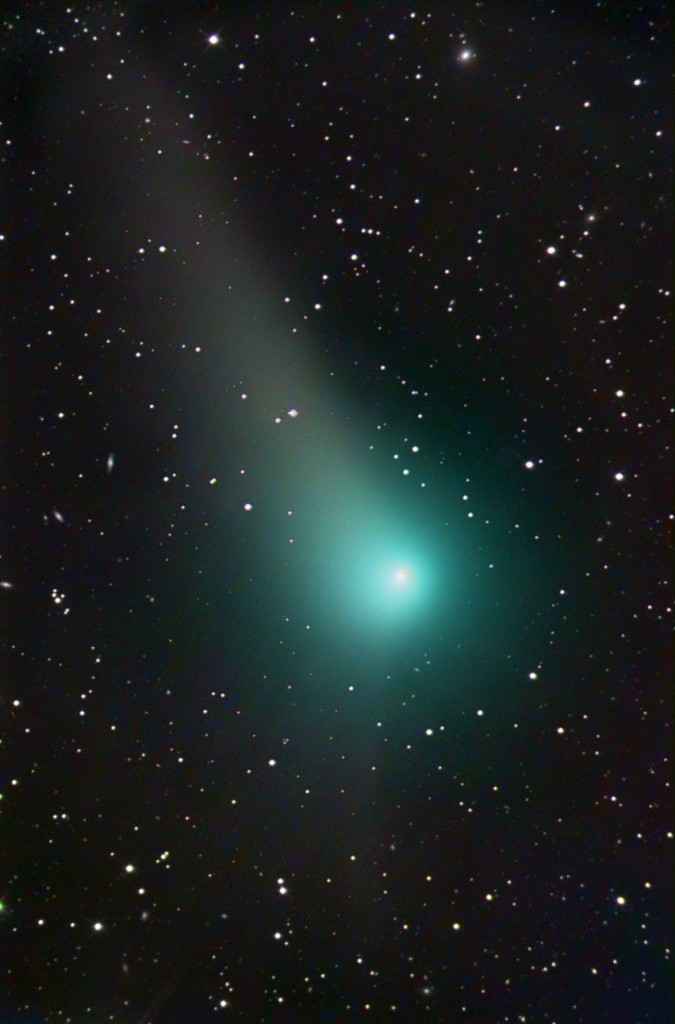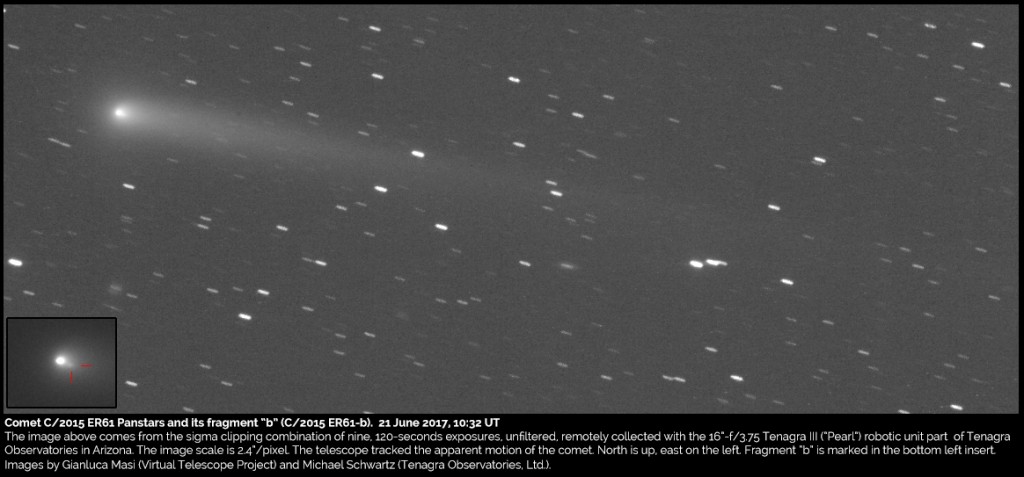ALPO COMET NEWS – AUGUST 2017
2017-July-31
When I first started writing this month’s Comet News the focus was going to be on how after 8 months that saw 8 comets reach 10th magnitude or brighter, the rest of the year was going to bring a bright comet drought. While this may still be true, a new discovery provides some hope that this Fall will see at least one come bright enough for most small telescope observers.
Evening C0mets
C/2015 V2 (Johnson) [Perihelion on 2017 June 12 at 1.64 au]
Comet Johnson is no longer visible from the northern hemisphere. By the time it heads far enough north to be seen by most northern observers it will have faded beyond the reach of all visual and most CCD observers. Southern comet watchers will still be able to follow Johnson this month as it moves through Centaurus (Aug 1-25) and Lupus (26-31). Currently around magnitude 9.0, it will fade by another magnitude this month as it moves away from the Sun (1.77 to 1.95 au) and Earth (1.35 to 1.83 au).
71P/Clark [Perihelion on 2017 June 30 at 1.59 au]
Discovered back in 1973, periodic comet 71P/Clark is making its 8th observed return. Similar to the last two months, Clark will spend all month in Scorpius. Recent reports place the comet between magnitude 10.5 and 11.0. Steady fading should continue as the comet retreats from the Sun (1.62 to 1.69 au) and Earth (0.79 to 1.04 au).
29P/Schwassmann-Wachmann 1 [Perihelion on 2019 March 7 at 5.77 au]
Regular outbursting comet 29P/Schwassmann-Wachmann 1 is now on the evening side of opposition near the Capricornus/Aquarius border. Always active, the comet can reach 12th magnitude during its outbursts. As August begins it is at magnitude 14 and slowly fading after a recent outburst. Monitoring of 29P’s outbursts will help better constrain its rotation period and outburst mechanisms. This is one comet where rapid changes in brightness and coma morphology make day-to-day monitoring worthwhile.
Morning Comets
C/2015 ER61 (PANSTARRS) [Perihelion on 2017 May 9 at 1.04 au]
C/2015 ER61 (PANSTARRS) reached perihelion back in May and has faded rather rapidly to between magnitude 10.5 to 11.5. The comet will continue to fade as it moves away from the Sun (1.69 to 2.04 au) and Earth (1.67 to 1.68 au). ER61 is a morning object this month moving through Taurus.
217P/LINEAR [Perihelion on 2017 Jul 16 at 1.24 au]
217P had a nice apparition last time around in 2009 when it brightened to 9th magnitude. This year’s apparition won’t be as good with it only brightening to 12-13th magnitude. Southern CCD observers will be able to watch it as it moves through Orion all month. The comet is now moving away from the Sun (1.25-1.36 au) and Earth (1.44-1.48 au). CCD observations are especially requested as 217P displayed some interesting jet features in 2009.
C/2017 O1 [Perihelion on 2017 Oct 13 at 1.51 au]
Comet Assassin! No it’s not the name of the latest video game your kids or grandkids are playing, but it is the possible name of a bright comet discovered by the ASAS-SN (All-Sky Automated Survey for Supernovae) project. C/2017 O1 was first seen with the the ASAS-SN quadruple 14-cm “Cassius” telescope on Cerro Tololo, Chile on July 19 UT (discovery Astronomical Telegram #10597). In the first few days after discovery, the comet experienced an outburst to magnitude ~10.5. A report by Erik Bryssinck & F.-J. Hambsch on the comets-ml suggest another small outburst occurred between July 28 and 29 UT.
What the future holds for C/2017 O1 is still unknown. Here is what we do know. C/2017 O1 appears to be a long-period comet though whether it is dynamically new or old is still to be determined. The comet is currently 1.82 au from the Sun and 1.51 au from Earth. Those distances will drop to 1.63 au and 1.07 au by the end of the month. It is a morning comet moving northeast through Eridanus (Aug 1-12), Cetus (12-19) and Taurus (19-31). Perihelion occurs on October 14 at 1.51 au from the Sun and closest approach to Earth on October 17 at 0.72 au. If its current 10th magnitude is indicative of its true brightness (and not just the result of a short-lived outburst), the comet may brighten to 7th-8th magnitude in October. At that time it will also be a northern circumpolar object.
As for the name or lack thereof, the IAU Small Body Nomenclature committee will probably decide on the official name for C/2017 O1 when the next official orbit is released. It will be interesting to see if it will be Comet ASAS-SN, Comet ASASSN or even be named after the human ASAS-SN member who first saw it.
Other Comets in the News
(457175) 2008 GO98
Gianluca Masi and Efrain Morales Rivera have submitted images this past month of comet (457175) 2008 GO98. If (457175) 2008 GO98 seems like a strange designation for a comet, it is. The designation is actually for a numbered asteroid. Between its first reported sighting in 2001 and early 2016, this object didn’t appear to display any cometary activity. All that changed in early 2016 when the object rapidly brightened from 21st to 17th magnitude. Though well observed in 2016, no one noticed the brightening or any cometary features. It wasn’t until July 3rd of this year, that Greg Leonard noticed a coma and short tail in images taken with the Mount Lemmon 1.5-m.
While on an orbit that resembles a member of the Hilda family of asteroids, backward integrations of its orbit show that it has made many close approaches to Jupiter in the past and 300 years ago was on a Centaur orbit entirely exterior to Jupiter. This all suggests that it is not an asteroid that is acting like a comet but rather a comet that mimiced an asteroid for awhile.
International Comet Quarterly
The original clearinghouse of comet photometry and observation has returned after a hiatus of 7 years. The April 2010 issue (ICQ 154) has been published. A free downloadable copy is available at the ICQ website.
As always, the Comet Section is happy to receive all comet observations, whether images, drawings or magnitude estimates. Please send your observations via email to < carl.hergenrother @ alpo-astronomy.org >.
- Carl Hergenrother (ALPO Comet Section Coordinator)





